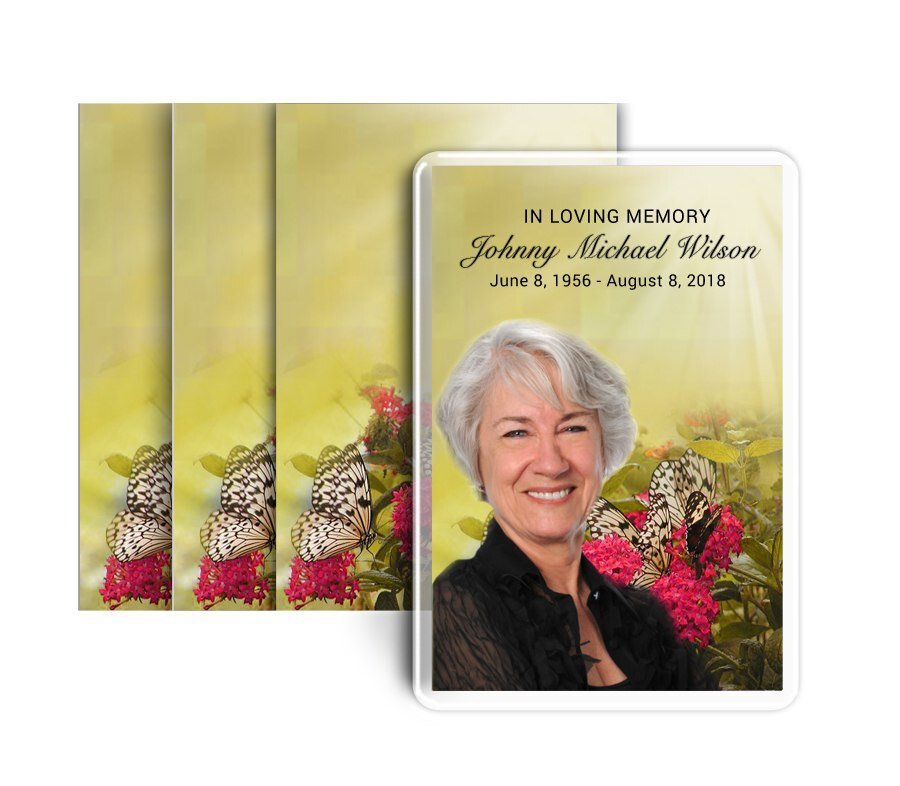Designing Funeral Prayer Cards for Religious and Non-Religious Services

Funeral prayer cards hold a special place in memorial services, offering attendees a tangible keepsake that reflects the life and beliefs of the deceased. These small, beautifully designed cards often feature prayers, inspirational quotes, or personal tributes, making them a deeply meaningful element of any service. Whether for a religious or non-religious gathering, the design of these cards requires careful consideration to ensure they honor the individual’s memory and provide comfort to those in mourning. This article explores the key aspects of designing funeral prayer cards, catering to both traditional religious contexts and more secular, non-religious ceremonies.
The Purpose of Funeral Prayer Cards
Funeral prayer cards serve as both a practical and emotional component of memorial services. Their primary purpose is to provide attendees with a physical token of remembrance that they can take home. These cards often include a photograph of the deceased, their name, birth and death dates, and a meaningful verse, prayer, or quote. For religious services, the cards may feature traditional prayers or scripture passages that reflect the faith of the deceased. In non-religious settings, the content might include inspiring messages, favorite quotes, or secular poems that capture the individual’s personality and values.
Beyond their role as keepsakes, funeral prayer cards also serve as a unifying element for those attending the service. By distributing these cards, families create a shared experience, allowing mourners to collectively honor the memory of their loved one. The cards can also provide solace during moments of reflection, offering comforting words or imagery that resonate with attendees.
Elements of a Funeral Prayer Card
A well-designed funeral prayer card typically includes several essential elements, regardless of the religious or secular nature of the service. These elements ensure the card is both meaningful and visually appealing:
-
Personal Information: The name of the deceased, along with their birth and death dates, is a standard feature. This information serves as a reminder of the individual’s life and legacy.
-
Photograph: A photograph of the deceased is often included, capturing their likeness and preserving their memory. Families may choose a recent image or a cherished photo from earlier years, depending on the tone they wish to convey.
-
Inspirational Text: For religious cards, this might include prayers, scripture verses, or hymns. Non-religious cards often feature poems, quotes, or messages that reflect the personality and beliefs of the deceased.
-
Design and Imagery: The visual design plays a crucial role in setting the tone of the card. Common themes include floral patterns, peaceful landscapes, and symbolic imagery such as doves, crosses, or candles. Non-religious designs might incorporate abstract art, hobbies, or personal interests.
-
Acknowledgments: Some families include a brief note of thanks to attendees, expressing gratitude for their support and presence during the difficult time.
Designing Funeral Prayer Cards for Religious Services
Religious funeral prayer cards are deeply rooted in tradition, reflecting the faith and beliefs of the deceased. The content and design often draw from the teachings and symbols of the individual’s religion. For example:
-
Christian Services: Cards for Christian funerals commonly feature scripture passages, such as Psalm 23 (“The Lord is my shepherd…”) or John 14:27 (“Peace I leave with you…”). Images of crosses, angels, or churches are frequently used, and the card might include prayers like the "Hail Mary" or "The Lord’s Prayer."
-
Jewish Services: Funeral cards for Jewish services often include Hebrew prayers such as the Mourner’s Kaddish or Psalm 121 (“I lift my eyes to the hills…”). Simple, elegant designs with the Star of David or other traditional motifs are commonly chosen.
-
Islamic Services: Islamic prayer cards may feature verses from the Quran, such as Surah Al-Fatiha, and are often designed with Arabic calligraphy and understated elegance. Green and gold are popular color choices, reflecting themes of peace and eternity.
-
Hindu and Buddhist Services: These cards might include mantras, verses from sacred texts, or prayers for the soul’s journey. Imagery such as lotus flowers, deities, or serene landscapes is often incorporated.
When designing religious funeral prayer cards, it is essential to work closely with the family to ensure the content and visuals align with their beliefs and traditions. The choice of prayer or verse should hold personal significance, offering comfort and a connection to the deceased’s faith.
Designing Funeral Prayer Cards for Non-Religious Services
Non-religious funeral prayer cards focus on celebrating the individuality and personal values of the deceased. These cards often feature secular themes and content that resonate with attendees, regardless of their spiritual beliefs. Elements to consider include:
-
Inspirational Quotes and Poems: Secular quotes or poems that reflect the deceased’s outlook on life, such as “Do not stand at my grave and weep” by Mary Elizabeth Frye or “The Road Not Taken” by Robert Frost, are popular choices.
-
Themes and Hobbies: Incorporating the deceased’s passions, such as gardening, art, or travel, can add a deeply personal touch. For example, a nature lover’s card might feature images of forests or flowers, while an artist’s card could include brushes or paint palettes.
-
Modern Design: Abstract or minimalist designs are often favored for non-religious cards, providing a contemporary and versatile look. Families might choose color palettes or patterns that reflect the deceased’s preferences.
-
Personal Messages: Families can include heartfelt messages or anecdotes that highlight the deceased’s character, accomplishments, or sense of humor, creating a unique tribute that feels authentic and personal.
Non-religious funeral prayer cards offer a blank canvas for creativity, allowing families to craft a design that truly reflects the essence of their loved one’s life.
Tips for Designing Meaningful Funeral Prayer Cards
Creating a funeral prayer card is a delicate task that requires attention to detail and sensitivity. Here are some tips to ensure the design process is smooth and meaningful:
-
Collaborate with the Family: Involve family members in the design process to ensure the card reflects their wishes and the personality of the deceased.
-
Choose High-Quality Materials: Select sturdy cardstock or premium paper for printed cards to create a lasting keepsake. For digital versions, use high-resolution images and design files.
-
Balance Content and Design: Avoid overcrowding the card with too much text or imagery. Aim for a clean, elegant layout that is easy to read and visually appealing.
-
Incorporate Symbols Thoughtfully: Choose symbols and imagery that hold significance for the deceased and their loved ones, whether religious or secular.
-
Proofread Thoroughly: Ensure all names, dates, and text are accurate. Typos or errors can detract from the card’s meaning and impact.
Printing and Distribution
Once the design is finalized, families must decide how to produce and distribute the funeral prayer cards. Options include:
-
Professional Printing Services: Working with a professional printer ensures high-quality results and saves time during a stressful period. Many funeral homes offer printing services as part of their memorial packages.
-
DIY Printing: Families with access to a high-quality printer can produce the cards at home, using templates and printable funeral program materials available online.
-
Digital Distribution: For virtual or hybrid services, digital cards can be shared via email or through memorial websites. This option is eco-friendly and ensures distant relatives and friends can receive a copy.
The Emotional Impact of Funeral Prayer Cards
Funeral prayer cards are more than just keepsakes; they carry deep emotional significance for attendees. These cards serve as a tangible connection to the deceased, offering comfort and a sense of closeness. For many, the card becomes a cherished memento, kept in wallets, photo albums, or on display at home. The act of distributing and receiving these cards fosters a sense of community, allowing mourners to support one another in their grief.
For families, the process of designing the cards can be a healing experience. Choosing the content, images, and design elements provides an opportunity to reflect on the deceased’s life and legacy. This act of remembrance helps families celebrate their loved one’s journey while finding solace in their memories.
Conclusion
Designing funeral prayer cards for religious and non-religious services is a deeply personal and meaningful process. These small yet powerful mementos offer comfort to attendees, honor the life of the deceased, and provide a lasting reminder of the love and memories shared. By carefully selecting content, imagery, and design elements, families can create cards that resonate with the unique personality and beliefs of their loved one. Whether rooted in tradition or crafted with modern creativity, funeral prayer cards remain a cherished part of memorial services, bridging the gap between loss and remembrance.
Also see: funeral program
For more on this topic, visit The Funeral Program Site.
© The Funeral Program Site - Funeral Programs, Funeral Program Templates and Cancer Ribbons





























